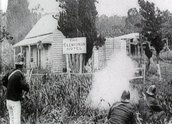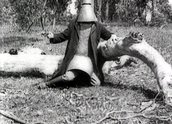


The Story of the Kelly Gang (1906)
Synopsis
When it opened on 26 December 1906 The Story of the Kelly Gang was six reels long, or close to 60 minutes, a duration that was unheard of. What remains of the film is almost 10 minutes, much of which is damaged, so a detailed synopsis of the original film is difficult.
The scenes we have include the shooting of Constable Fitzpatrick, in which Ned Kelly defends his sister’s honour by shooting the policeman in the wrist; the ambush at Stringybark Creek, in which the Kelly gang shoot three troopers; the final showdown at the Glenrowan Hotel, in which Joe Byrne, Dan Kelly and Steve Hart are killed, the police set fire to the hotel, and Ned is captured in his armour after attempting to shoot his way out.
There are stills of some of the missing scenes, so we know the film included many of the major exploits in the Kelly legend – the stick-ups of the Euroa Bank and Younghusband’s station, the death of Aaron Sherritt, the ripping up of train tracks at Glenrowan in order to stop the arrival of more troopers; and a scene in which the gang members look at a poster proclaiming the reward for their capture. There is also a still of Kate Kelly on a white horse holding a gun.
A further complication is that there were different versions of the film at different times. The gang’s raid on a Jerilderie bank was filmed later and added to the existing film for its release in NSW in February 1907. There were further additions when it was re-released in 1910.
Up until the 1970s, no fragments of The Story of the Kelly Gang were known to have survived – it was one of Australia’s many 'lost’ silent films. In the mid-1970s, ten frames were discovered with a futher small roll of negatives from the film turning up in 1979. In 1981 some children famously discovered a further approximate 400 feet of decomposed release print in a Melbourne rubbish dump, some of which was saved. The version of Story of the Kelly Gang curated here is from the version as it stood in the 1980s, at approximately nine minutes in length.
During research for the film’s Centennial Restoration, the National Film and Sound Archive unearthed a substantial fragment – another 11 minutes worth of film. The reel contains the scene of the Kellys at the Younghusband homestead. With this additional fragment the film, projected at its original 18 frames per second, what survives now runs at just under 18 minutes in length. The National Film and Sound Archive – along with technical labs in Amsterdam – digitally restored, frame by frame, this version of The Story of the Kelly Gang in 2006 and it was released on DVD in 2007.
Curator’s notes
Whether or not The Story of the Kelly Gang is the world’s first narrative feature film is still debated, but that has no impact on its importance as Australia’s first narrative feature film.
It is difficult now, 100 years later, to imagine the impact the film must have had on audiences in 1906. The film was made just 26 years after Ned Kelly was hanged in 1880. There had been several plays based on his exploits so the legend was still growing.
The Tait family were well-known in Melbourne showbusiness as the owners of the Athenaeum Hall, a concert venue which also ran film programmes. John and Nevin Tait acted as producers; their brother Charles directed the film. Several members of the family took roles, including Elizabeth Tait, wife of the director, who played Kate Kelly. Much of it was filmed at her family’s property at Heidelberg near Melbourne. Interiors, including the inside of the Glenrowan Hotel, were constructed in the back yard of Charles Tait’s home in Melbourne. These sets used sunlight as the only illumination.
The production was a joint venture with two chemists, William Gibson and Millard Johnson, who knew how to shoot and develop film. Johnson was the cameraman, Gibson looked after the lab work. The limitations of film technique in 1906 are obvious in the production – there are no close-ups, and the camera moves are limited to the occasional move left or right, to re-frame the action. The acting is rudimentary and the editing almost non-existent in what fragments remain.
Nevertheless the film is staged for maximum excitement, with a blithe embrace of as much screen violence as they could pack in. Ned and his gang are shown shooting troopers at close range in the Stringybark scene, and the action inside the hotel includes a memorable moment in which Dan Kelly and Steve Hart shoot each other rather than allow themselves to be taken alive. Ned’s capture too is filmed effectively, as he staggers toward camera, guns blazing. Audiences had never seen anything so bold, and the film was presented with live sound effects and narration, so it was anything but silent. Scenes were also tinted for dramatic effect, as in the red colour used to enhance the effect of the burning of the hotel.
Audiences all over the country flocked to see this film, which stayed in distribution for most of the next 10 years (in various forms). Several fortunes were made on the basis of its receipts. It’s true also that the film kick-started the trend for bushranging films, many of which were made in the next seven years, until 1912, when the police succeeded in getting a ban on bushranging films in the states of Victoria and New South Wales.
Secondary curator’s notes
by Elizabeth Taggart-SpeersThese brief surviving fragments show heavy nitrate damage, and possibly include out-takes from the original release.
Cellulose nitrate, the film support for this title, was used until the 1950s. Nitrate was easy to make and tough, however it was chemically unstable and highly flammable. The rate of combustion for cellulose nitrate film is about 15 times that of wood. In the early days of the motion picture industry, movie houses and even film studios had fatal fires.
Originally The Story of the Kelly Gang would have been accompanied by an on-stage lecturer or stage actors who supplied commentary and sound effects. There were no intertitles.
The romantic image of bushrangers attracted censorship problems. Concerns for law and order caused bans not just for this film but for many later films of the same genre. In April 1907 screenings of the film in Kelly’s own territory around Benalla and Wangaratta were banned.
- Overview
- Curator’s notes
- Video 3 clips

- Principal credits
- Find a copy
- Comments 2
- Map
- Add your review




